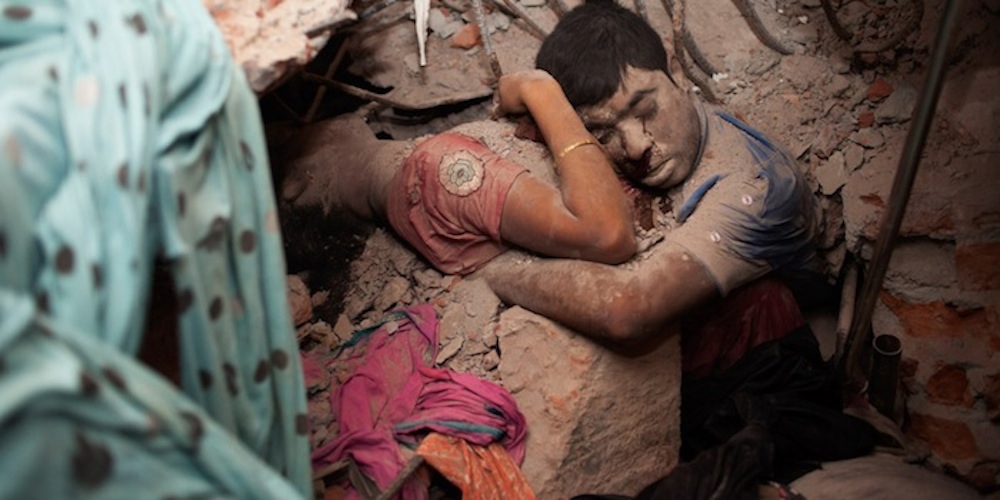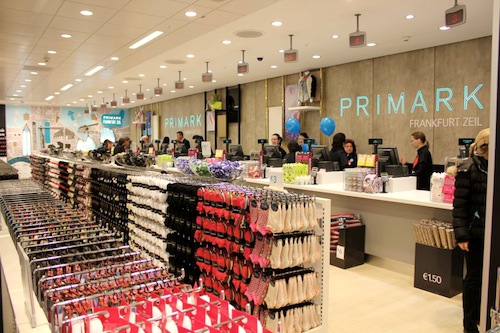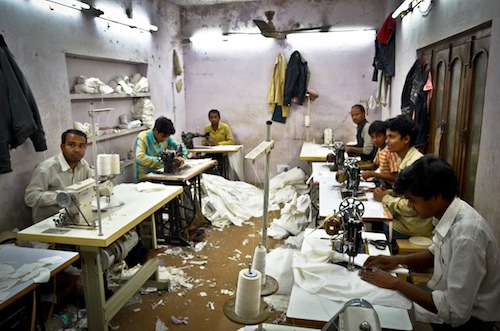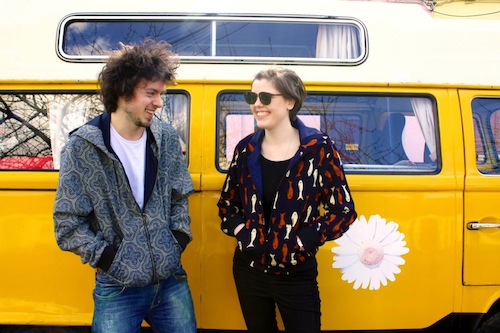Rachel Lavin | Contributing Writer
photograph taken by Bangladeshi photographer Taslima Akhter of a couple embraced in the rubble of the collapsed Bangladesh factory building in April 2013 sent shockwaves around the world. The photo, captures two lovers’ final embrace, the blood trickling down the man’s cheek, like a tear, as his head appears to rest on the woman’s chest. This photo sent a powerful symbol to western lovers of cheap clothing. It showed them the devastation caused by their own complicity with the industry whose low ethical standards led to this collapse.
This photo sent a powerful symbol to western lovers of cheap clothing
The building itself, Rana Plaza, was a garment factory, which manufactured clothing for western shops such as Primark, Mango, Benetton and Walmart. This cheap fashion industry is a relatively new phenomenon. The last twenty years has seen a massive rise in demand for cheap clothing and accessories, with major retailers outsourcing manufacturing to developing nations to cope with market competition. This radically drove prices down. With an ever-growing demand for cheap clothing, not only have retailers outsourced their manufacturing to the third world, therefore sinking the local manufacturing in the West, but working conditions in the third world are pushed lower and lower to meet cheaper price demands.
Every year in Britain 1.5 million tonnes of unwanted clothing and textiles end up in landfills
For instance, in 1990 the United States made 50% of the clothing its consumers purchased. Today however, this has fallen to just 2% and China now makes a staggering 41% of America’s clothes. Clothes that used to be expensive and valued are now cheap and disposable. For example, America buys 20 billion garments a year and yet the average person throws away 30 kilos a year. Every year in Britain 1.5 million tonnes of unwanted clothing and textiles end up in landfills. This level of cheap production and high amounts of waste is unprecedented in the fashion world, and it’s only getting worse.
“They are by-products of the fashion industry”
To discuss this fast-fashion phenomenon I met with Rosie O’Reilly & Kate Nolan of Re-dress, an Irish organisation dedicated to better practices and standards in the fashion industry. As Kate explains: “With seasonal looks driven by advertising and marketing, the end result is that we’re consuming four times more clothes than we did in the eighties. And you can be guaranteed at least ninety per cent of those end up in a landfill. Sixty per cent of them are synthetics so they’re not biodegradable. They’re going to be here longer than we are. They are by-products of the fashion industry.”
Meanwhile in the developing nations, while factory numbers have soared standards have dropped. Fuelled by an unprecedented demand for ‘fast fashion’ these cheap fashion manufacturers are widespread in the third world. For example, in Bangladesh clothing exports account for seventy per cent of GDP and the industry employs over three million workers.
For Rosie, acknowledging the impact of globalisation is essential when trying to imagine an alternative future for fashion: “You don’t buy on the high street without buying into the global trading kind of systems. Several parts of one garment are coming from all over the world, your buttons might be produced in China, your denim might be woven in India, it might be picked off the fields in Africa or Pakistan. When you buy into that you’re buying into that system.” Kate points out that exploitation of workers is intrinsic to this global system.
exploitation of workers is intrinsic to this global system
These sweatshops mostly employ low-income semi-skilled women, and child labour is common: “You know where we talk about ‘the great mobilization of female workers’ in the fashion industry, particularly in developing countries, really what’s happening is that the women are getting up extra early and maintaining the household then going to work for fourteen hours, then coming home to the rest of the household work. They never are able to find the time to unionize or actually fight for their rights, and you know when they get to child rearing age they’re usually dropped off the system anyway because there’s no such thing as maternity leave in Bangladesh or Pakistan.” Rosie develops this point to include the impact on children: “Even if child labour isn’t prevalent, a lot of the time you’ll have children living in the factories with their parents because these women are trapped in a poverty cycle so they can’t get out of the poverty trap. So there’s no mechanism for them to get into school or an education system. It’s just a poverty cycle, a revolving door.”
Workers dying individually as a result of poor conditions are largely unaccounted for
Aside from an unjust living wage, these workers live and work in dangerous, unjust and bleak conditions. There is little in the way of building inspections, which leads to dangerous working conditions, hence the Bangladesh building collapse. The collapse of the Rana Plaza however, was not the first disaster of its kind. For instance, just five months before in November 2012, more than a hundred people died in a fire at the Tazreen Fashions factory outside Dhaka, and these are just the large-scale disasters. Workers dying individually as a result of poor conditions are largely unaccounted for. Working conditions can be hazardous to one’s health, be it long working hours in cramped factories, or the use of toxic pesticides required to meet the high demand for cotton production or dangerous chemicals used to dye materials. With conditions spiralling downward in a first world fuelled race to the bottom for workers of the third-world nations, what can be done to prevent any more destruction and exploitation? Re-dress is an attempt to combat exploitation of workers and pollution of the environment. Through different campaigns Re-dress aims to promote better fashion.
Both Kate and Rosie came to see the flaws of the “fast fashion” industry from the inside. They began as a fashion buyer and designer respectively. As Rosie recalls: ‘The reality of the clothing industry sort of hit home, especially with my background in sociology and philosophy. I started scratching the surface about some of the environmental and social issues, and it opened my eyes to what was going on under the glossy surface of this industry. Kate had a similar moment of disillusionment: “I ended up working in India for a year and a half in a factory over there supplying for a high street retailers at that very fast pace and with shorter and shorter leap times, lower prices, higher volumes. I suppose after a while the gloss of traveling the world wears off and you start to really see what’s going on and at the end of the supply chain. It’s just really horrific, the low labour standards and, in my own personal experience, child labour. So that turned me on my heel … We came back and were trying to figure out how we were going to continue on in the fashion industry with what we knew and what was becoming apparent to us.”
In 2008 Rosie and Kate planned an event in their living room to discuss better fashion practice, which quickly turned into a three-day event with exhibitions and conferences attended by well over a thousand people from the fashion industry. This is how Re-dress was born. Rosie was not surprised by the apetite for change that was exhibited: “I suppose the response was so vast and it was so obvious that something was needed and people wanted to have those conversations and start talking about the supply chain. Since then we’ve basically been working in education and awareness … And we run creative fashion projects as well everything from art installations to lectures and talks to DIY fashion training.”
consumers need to realize that when they put their hand in their pocket they vote
Despite the harm that parts of the fashion industry are causing, Re-dress are not calling for a boycott of high street stores: “We sit down with garment workers and they don’t want you to stop shopping. They need the money. It’s not as simple as a boycott, we’d never advocate that. But consumers need to realize that when they put their hand in their pocket they vote. When you are supporting a brand and you like the brand it’s your duty then to ask questions of that brand. Check their website and look at their work and their social responsibility.”
One central example of this social responsibility can be seen in the Bangladesh Accord. Following the Rana Plaza Collapse, 1.3 million consumers signed an international petition to get high street chains to sign the accord committing to better safety standards for the factories they use. Kate welcomes this development: “That really clearly said ‘you’ve got to change what you’re doing in Bangladesh.’ This was just one incident … but very quickly retailers realised that consumers are not comfortable with the system that they have, especially when these kind of things happen. In the media glare to date a hundred and twelve companies have signed the Bangladesh agreement. Two million workers in Bangladesh are covered under that agreement and for the first time in their lives they’re looking at a safe work space where they’re not going to be risking their lives going there daily.”
“Cheap clothes are defined by cheap labour whether you like it or not”
Re-dress have expanded the Clean Clothes Campaign to Ireland. This campaign is aimed at improving conditions in the global garment industry and helping workers earn a living wage. Rosie elaborates on the purpose and methods of the campaign: “Cheap clothes are defined by cheap labour whether you like it or not. But, when we were working in the industry, one thing that everyone was very shy of and would just generally not talk about was labour issues. The Clean Clothes Campaign gives us the platform to talk specifically about labour rights. It is about getting these conditions to end and we’re here to let consumers know what’s going on.” In favour of the Clean Clothes Campaign, Re-dress frequently turns to graffiti as a creative medium to spread their message about a living wage.
“go Irish if you can, do a sewing course, make it yourself”
Another essential element to better fashion is supporting local-made fashion and just last year Rosie and Kate launched a new design label, We are Islanders, producing ethical and sustainable Irish fashion. In terms of the average consumer, Re-dress offers this advice: “Think first, before you spend the money look into the brand you are supporting, swap shops, frugality, quality over quantity, shop vintage, shop in your charity shops, shop up in local designers, The Loft or Beaux, go Irish if you can, do a sewing course, make it yourself.”
Re-dress are not the only Irish initiative for better fashion. This year Trinity saw the establishment of Ethnic Threads, a company set up by fourth year students John Frewen and Jack Danaher. As Jack explains: “John was travelling through Uganda one summer and would stop off at small markets in villages where they were selling rolls of kitenge (traditional African patterned material) fabric. He bought a number of different rolls when he was away and then when he got home he met a woman who said she would be happy to make hoodies out of the material that he had bought. Once they were made they sold like hotcakes so plans were made to see if it could become a more sustainable long term business.”
an organization that trains women who would otherwise be forced into prostitution in marketable skills such as textile production
Frewen turned to Lifeworks to produce the materials, an organization that trains women who would otherwise be forced into prostitution in marketable skills such as textile production to give them a sustainable source of income and a viable alternative to prostitution. Revenue generated by Lifeworks is invested into education schemes whereby the women employed travel around to schools to teach children basic HIV prevention practices from an early age.
Frewen and Danaher want to work toward establishing safe workplace and ethical conditions for their workers in the future: “Long-term, we aim to establish our own Lifeworks-style producer in Kenya. It’s a fairly audacious goal so early on in the process but John and I have already been in contact with someone who is planning to set up an ethical production factory in the slums in Nairobi and wants to work with us to set it up.”
From organizations like Re-dress to small startups like Ethnic Threads it is clear that even in a small country like Ireland, there is a growing awareness about the damage being done by the fast fashion industry to developing nations. Cheap clothes are costing lives but with responsible shopping and ethical choices, modern consumers can choose better fashion to help better lives.










